Home
Weblog
Schedule
Contact Us
Pictures
FAQ
|
« February 2007 |
| April 2007 »
This afternoon we dropped in on an Airstream rally being held about 25 miles away, by the newly-formed Four Corners Unit of WBCCI. We didn't know a single person attending, but a couple of them invited us by email anyway. Rather than move the trailer out of our current campground, we just drove over in the afternoon, and on the way we encountered the International Wildlife Museum by chance.
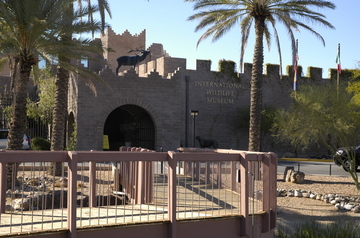
The museum houses an impressive collection of stuffed and/or mounted creatures, from butterflies to elephants, and everything in between. The only live creature we spotted was a tarantula; Everything else is a creation of taxidermy or model-making. It's a lot of dead critters but the presentation is good and well worth the $7 admission. The only part that we didn't linger over was the extensive presentation of scat from dozens of different animals ... each specimen extremely life-like and fresh-looking.
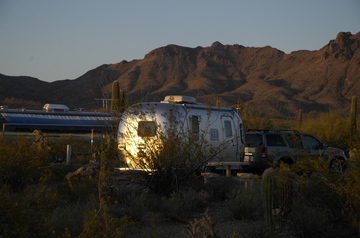
After the museum we cruised over to check out the Airstreams. Not bringing the trailer turned out to be a missed opportunity, because the rally was being held at the beautiful Gilbert Ray Campground in a county park. The views at Gilbert Ray are panoramic, and from many campsites on Loop C we could see the observatories of Kitt Peak to the south as well as the Tucson Mountains to the north. It's a sweet spot to go camping, especially with the skies as crystal-clear as they have become.
Even though we didn't know anyone, it took only about a minute to meet Brent and Tiffany, the hosts of this event, and then we were quickly introduced to the rest of the crowd. Although we planned to stay only a few minutes to say hello, they dragged into the potluck dinner, Emma hooked up with another little girl, and then there were tours of people's trailers, and it ended up being about 8 p.m. before we finally said goodnight.
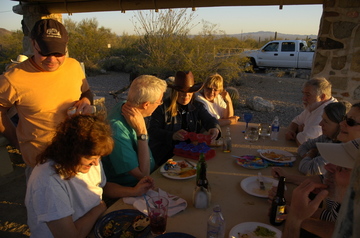
Most of the rigs at the rally were new ones, but we did spot an immaculate 1989 Airstream Land Yacht "Squarestream" and get a quick tour of it. The Squarestreams may be regarded as "not true Airstreams" by some but I think they are a fascinating part of Airstream history and fun to have at any rally.
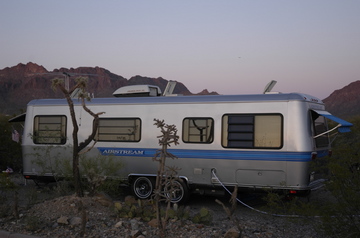
Had we towed our Airstream over we'd probably still be sitting up with some of the folks, talking and making some new friendships. As it was, we got invited to a couple of other events, including the Albuquerque Balloon Festival in October, and we'll probably go to one thing or another. The balloon fest sounds ideal -- we get to park on a hill overlooking the launch site and watch balloons flying around for days. I'll have to reserve that soon.
My friend Brett had a t-shirt made for me a few weeks ago, which I picked up at General Delivery, Borrego Springs CA. It has a stick-figure drawing of a person at a computer and the slogan, "Time to make the blog". That's me every night. I'm like the Dunkin' Donuts guy who has to get up at 4 a.m. to make the doughnuts, every day.
(I like "making the blog" but it is a chore many times and there are a lot of times I wish I could just go to bed and forget about it. But you, the dedicated reader, make it all worthwhile.)
However, the t-shirt joins an alarmingly fast-growing pile of t-shirts which I have been given in the course of this trip. I now have an entire tub full of nothing but t-shirts beneath the bed. Every single one is a great memory -- the initiation ceremony with the Dixie Campers, the weekend at Ft Wilderness with Trailerworks, visiting the Airstream factory, etc. But my limited wardrobe space means that the heap must be culled down periodically.
Perhaps this is the true reason we need to buy a house. I could decorate the den with framed shirts commemorating stops on our trip. Forget the "home base" discussion, and school for Emma -- we just need a hangar for all the souvenirs we've accumulated!
Of course, the shirts are only one example. We've also managed to collect a rather substantial pile of rocks, and amazingly, fish sculptures. We never set out to collect sculptures of fish, and yet we have three so far: two of glass and one of pink gypsum. All have been spontaneously given to Emma, and all of them are substantially heavy. Needless to say I never expected fish sculptures to be one of the major outcomes of traveling full-time for 18 months, but here they are.
As I've mentioned, we periodically off-load excess items to our storage unit in Vermont. The problem is that some day we'll come back to that storage unit and have to deal, somehow, with all the souvenirs. When I think about getting a house, I think about that storage unit and the many mysteries contained within it, and I have an involuntary shudder. There are boxes in there that we still do not fully comprehend, secrets of our former life that we have long since forgotten. It's like an ancient Egyptian tomb filled with artifacts for the afterlife, except we have to deal with them while we're still alive.
I can see what might happen. We'll find a house here in the southwest, and call for all the stuff in storage to be put on a moving truck. Thousands of miles and thousands of dollars later, the truck will drop off a hundred cardboard boxes, and we'll sort through them, only to find 572 assorted t-shirts, 200 pounds of rocks, and three fish sculptures. It will make for an interesting decorating theme.
Tucson is one of the nation's best cities for bicycling. Great weather all winter long, generally flattish trails, plenty of scenery and lots of bicycle-friendly areas. We grabbed the two folding Birdy bikes and Emma's $39 Wal-Mart special, to take Emma on her first bike path ride ever.
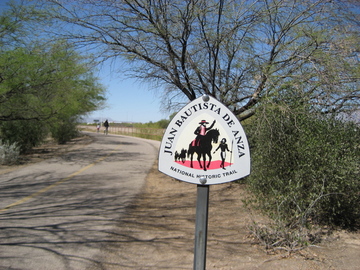
The trail we chose today runs along both sides of the Santa Cruz River near downtown Tucson. The Santa Cruz, like all the riverbeds in this area, is dry most of the year. The scenery varies from bad to great. Our starting point was at 29th St near the Pima County prison, so the view started with razor wire and guys playing basketball in orange jumpsuits. But it quickly got better, with a nice view of A Mountain, and lots of little critters along the path (ground squirrels, a large lizard, roadrunners).
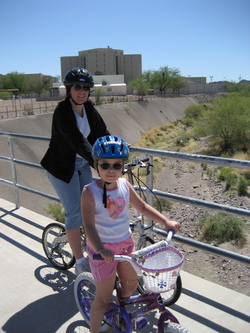
The Garden of Gethsemane is a nice stop along the trail. An artist named Felix Lucero dedicated his life to sculpting religious statues, and he made a set of them from concrete with sand & rock taken from the Santa Cruz river bed in 1945. The statues are in rough shape from weathering, floods, vandalism and other attacks, but undergoing restoration. Their present location is a lush garden inside a tall iron fence, free to the public.
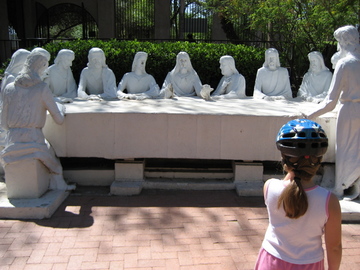
Emma's first major bicycling outing was a success. Yes, she managed to stop every 300 feet for one thing or another. Everything got her attention and called for a pause in the action: birds, dogs, amusing signs, itches, wedgies, plus multiple stops for water and snacks. But at the end of about five miles she was still lively and said, "That was awesome!" when we pulled into the parking lot. I expect we'll be doing a lot more cycling as a family in the near future.
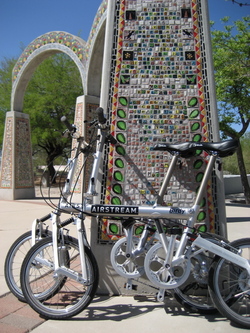
This trail is officially part of Tucson's linear Santa Cruz River Park, and is also part of the historic Juan Bautista de Anza National Historic Trail. We last encountered the story of de Anza when we were at Channel Island National Park in California over a year ago. His voyage to scout land for the Spanish crown is an incredible story, ranging from present-day San Francisco south well into Mexico. I would like to find a good book on that tale next time I'm prowling through a NPS bookstore.
Our days seem progressively more ordinary as we sit here without moving. The adventures have been limited. Today, a haircut, some groceries, drop off a disc at Blockbuster, check out the local Thai restaurant, work, work, work ... all very suburban and completely at odds with what we've done for the past year and half.
Eleanor has reminded me that it was only 11 days ago that we left Organ Pipe Cactus National Monument. Funny, it seems like weeks to me. And here I was thinking we needed to break out this weekend for a trip ...
Normally after a cold front passes through I'm used to seeing clearer skies. It has been beautiful today but the dust from yesterday's high winds is still visible against the backdrop of the mountains. In a few days it should be settled, perhaps even as soon as tomorrow, and if there's a chance to break away from work we may take half a day to drive up to Mt Lemmon.
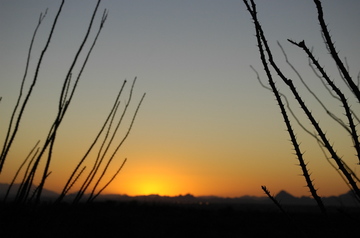
Sunset between the ocotillo
Another symptom of wanting to hit the road again is finding myself idly browsing the National Park Service website. Coming up on our list is Chiricahua Nationa Monument, not far southeast of here. Chiricahua is at higher altitude so we were waiting for the weather to warm a little more before going.
Today I noticed that the roads in the park and the park campground have a 29-foot trailer limit. Our trailer is called a 30 but in reality is 30 feet 10 inches long, so we can't stay in the campground. But we can still visit the park. We'll just have a few logistics to work out.
Eleanor has been reviewing schools and their schedules. Turns out that the 3-month summer vacation we remember as kids no longer exists. Now schools give a couple of weeks here and there, with school being in session nearly year-round.
Whose dumb idea was that? A schedule like that is going to cause us huge trouble, since I have a travel schedule (rallies, events, meetings) that will persist even after we stop full-timing. Will I have to go alone, thus taking us apart for weeks at a time? We're not psyched. We've been together every day since Emma was born, with few exceptions, and we like it that way. This is going to take some serious consideration.
Arizona has an interesting range of weather. Today the forecast was for "blowing dust" due to high winds. Here, dust is a form of precipitation, like rain or snow in other parts of the world. The wind whips it off the ground and into the air where it hangs and spreads for miles.
The effect is interesting the first time. The mountains that ring the Tucson metro area grew hazy and indistinct today, and walking around we felt the delicate pelting of sand on our shins. I opened my mouth too wide while walking into the wind and found my tongue coated with dust. It's sort of a desert equivalent of having snow flurries blowing into your face.
In the summer a "monsoon" season comes. This means thunderstorms rolling in from the west, filling all the dry riverbeds and washes with surging brown water, which disappears within a few days. All over this town there are "riverside" parks with no water, and bridges that cross nothing but rocks and sand. They come to life in the monsoon season, when Tucson goes from having very little water to more than it can handle.
We have resolved to slow down on the house-hunting. In the past week it has been consuming every spare moment. Now that we're getting up to speed on the local market and neighborhoods, we're feeling like we should slow down and put more of our spare time into exploring the attractions of southern Arizona. There's still so much more for us to see and do in this area.
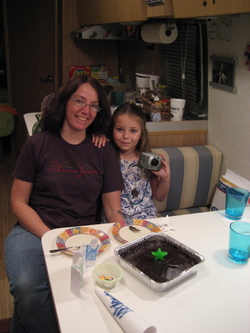
Today is Eleanor's 23rd birthday. Ooops, that's a typo. Well, you know what I mean.
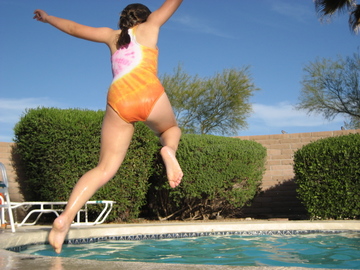
I thought this picture from today was analogous to many things we've done in the past two years. Selling the house, full-timing, picking a new place to settle, and now the real estate question. Sometimes you've just got to take a giant leap and hope for the best.
Of course we look before we leap. Although it may look to outsiders that our moves are random or oddly motivated, in reality moderation is our goal. We just happen to believe that conventionality should also be in moderation...
Likewise, a lot of people who have written to us and said, "I hope to do that someday!" I hope you do, too. For some of you, the stars will align and the right moment will be clear. But for most, there won't be a clear sign and at some point you will just have to make that leap, perhaps walking away from a perfectly good job, house, or neighborhood to take an adventure whose outcome is not guaranteed.
Emma's leap of the day was to get re-acquainted with the deep end of the swimming pool. Leaps like this are the outward signs of having conquered fear, which is always a great thing. Something to think about. Have you taken a leap lately?
As we consider the goal of having a home base, we've been tallying up the cost of this little luxury. This may be helpful -- in reverse -- for those of you considering full-timing in an RV, to see how much you'll save if you sell your house while you're out, like our friends Bobby & Danine.
Petey gave us an article that appeared in the Wall Street Journal, March 12, 2007, by David Crook, entitled, "Why your house isn't the investment you think it is". You may be able to find it online but I think you need a subscription to read it. The essence of the article was that houses are inefficient or even bad investments. Although people think they make money when they sell, in most cases they actually lose money when the cost of maintenance, taxes, insurance, and interest are factored in. Mr. Crook calls the check you get when you sell "a partial rebate" of what you spent, not a windfall or profit.
I looked at the numbers for our last house and found he's right, at least in our case. It looked like we made money on our house, but we actually lost money. We actually would have been better off not building on the land we bought, renting for the eight years we lived in the area, and then selling the land -- no kidding. For most people, it turns out, houses are something you buy because you want one, but from an investment standpoint you'd be better off putting money into rent and a mutual fund. It varies a lot from one local market to another, of course.
This naturally dampens our enthusiasm for having a "home base". Financially, it's pretty darned risky to plunge back into the real estate market when we don't expect to be here for more than 7-9 months per year. It's a huge luxury compared to the lightweight and inexpensive lifestyle of full-timing in the Airstream.
Our "housing" expenses, as full-timers, amount to $400-600 per month, plus an amortized $500 per month for the trailer itself. That includes our campgrounds, utilities (water, sewer, and propane), and maintenance. We don't pay property taxes, or for garbage pickup, electricity (except this rare moment while we are staying for more than a month), cable TV, lawn mowing, Home Owners Association or condo association dues, etc.
This stuff is probably ho-hum to you, but we've been on the road so long that all of the expenses associated with owning a house seem outrageous to us now. Since we sold our house two years ago, we have become used to putting money in the bank account and having it stay here. I had forgotten how invisible forces seem to suck it all out when you have a house to feed.
So why buy? There are a few reasons still left:
1) We have a child. She is doing wonderfully in our homeschooling program and we love the time together, but we'd like her to have more friends and at least a test of traditional school for a year or two. We never intended to be full-time travelers forever.
2) Health care. Continuity of care is important when you have any sort of chronic illness. We're pretty healthy right now, but there have been a few things to remind us that this can change. If one of us gets really sick, we'll want to park somewhere and deal with it. Having a home base makes that easier, since we'll already have known physicians and facilities to go to.
3) For people who are only going to full-time for a short period, hanging onto the house may be the smartest choice. The cost of selling (broker's fees) and the cost of re-acquiring a house (closing costs, market appreciation) can be more than the cost of just keeping the old homestead.
4) Satisfaction of ownership. Sometimes, you just want to have a "nice" house and feel like it's really yours. If owning a house is a big part of your self-image and makes you feel good, that's a reason to have one that transcends financial matters. But I'd recommend that frequent travelers or full-timers be honest with themselves and acknowledging the house for what it is: a luxury, not a financial decision.
Renting is also a good option. In our case, renting an apartment or house would probably be cheaper than buying for the short term, so a big part of the buy/rent decision will be our willingness to commit to the area for several years, at least. Having an Airstream to let us travel (and spend summers in the cool northeast) makes that commitment easier.
This is a work in progress ... we'll let you know how it goes ...
Every time we are in the real estate market I am always amused by what agents and sellers will say to market their properties. I know hyperbole is part of the game, and the goal of real estate listings is to get people into the houses, but still once in a while there's a real doozy that makes you shake your head and say, "What the heck were they THINKING?"
Case in point: "House has been well maintained and shows well." Reality: mismatched carpets, brown swimming pool, blue tape on the floor to cover cracking tiles, peeling ceiling containing asbestos, needs roof work, and most appliances are 15 years old. The funny thing is, we actually made an offer on this house but got outbid. (It was a nice neighborhood.)
Another example yesterday: "This house will sell itself. $2000 painting allowance." Right off the bat you know things are not going to look good when you see an allowance by the seller for repainting. As a bonus, the dog left us fun presents on the carpeting to step around like little land mines. An allowance for carpeting would have been more appropriate.
Then there's the real estate code. I'm sure if you've bought a house you're familiar with this arcane language. Guarantee: all phrases below are from actual listings.
"Charming" = Small, with stencils on the walls.
"Cozy" = Sized for Hobbits.
"Move-in ready" = Kind of like on eBay when they say "Trailer is ready to camp!" NOT
"Potential" = Needs lots of work.
"Opportunity knocks!" = Prior owner never pulled permits.
"Handyman special" = Bring a bulldozer.
"Rare opportunity" = Priced above market.
"Priced below appraisal" = Nobody wants it.
"Priced below market" = Previous buyer backed out.
"Bring all offers" = We know it's overpriced.
"View of riparian area" = House is next to a gully.
"A classic" = hasn't been updated in 30 years.
"Historic" = hasn't been updated in 50 years.
"Would make a good dog run" = Side yard is bare dirt.
Now, despite poking fun at the listings, I should say that we are extremely happy with the realtor who is representing us. He's tolerant of our quirks, endlessly patient, and incredibly responsive. There are a lot of "good guys" in the business and we're happy we found one. With his guidance ... and a few small miracles ... we'll find a home base eventually. In the meantime, the MLS will keep us amused. Isn't that what it is there for?
Our pals the Fabers invited us over for dinner tonight. They're the folks who went with us to Mexico ... was it only a week ago? It has seemed like two weeks, which I attribute to the crazy schedule we've had since we got back.
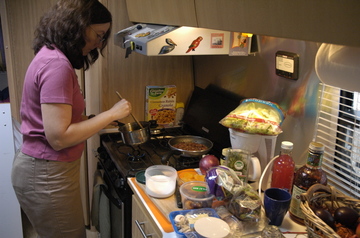
Eleanor whipped up an elaborate salad ... containing mixed spring greens, radiccio, endive, bartlett pear, maple-ginger glazed pecans, red bell pepper, mushrooms, balsamic marinated onions, apricots, shredded carrot, and proscuitto. She topped it with a homemade dressing: a balsamic reduction with ginger, apricots, and apple juice.
It was a meal in itself, but of course it was only a complement to Petey's delicious dinner of marinated pork loin, steamed asparagus, and sweet potato with butter & brown sugar. And then homemade lemon bars for dessert. So, we didn't suffer.
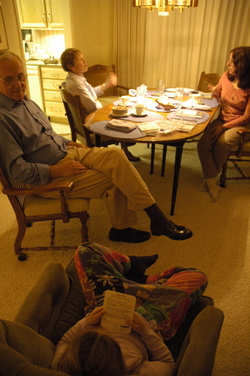
After dinner
We discussed some future trips that we might take ... and the Fabers' plan to be on the 2009 Capetown to Cairo trip. They are already signed up. That's going to be an amazing trip if it comes off. I'm tempted to go myself but who would run the magazine while we were out of touch for four months? It's hard enough to get a week off. My boss is strict about vacation time ...
The seasons are changing here in Tucson. We're getting blustery, wild weather. Yesterday high winds kicked up dust all over town and today thunderstorms kept rolling through.
In other parts of the country these weather events might not seem so dramatic, but here the sky is usually blue and clear. The dust turned it to brown pudding, the storms beat the sky until it was black and blue. It's a break from the ordinary, and fun to watch because it's wild but not as forbidding as other parts of the country. Tucson doesn't get hurricanes, tornadoes are a rarity, floods fill the washes as they are supposed to, and everything usually clears up pretty quickly.
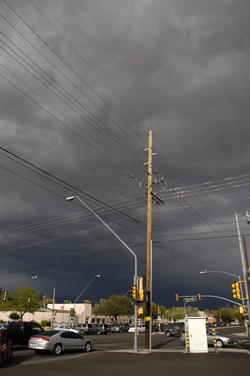
That's not to say that the weather can't be dangerous. The dust storms can completely obscure your vision, and driving down I-10 can be risky if one blows across. This evening we had a pretty good lightning show, too. But the rain that fell amounted to a paltry desert portion, enough to wet the ground a bit and then evaporate almost as quickly.
The saguaros and other desert plants will suck up what they can, expand a bit in their pleats like a person after a big meal, and be set for another long spell until the next few precious drops come by. We'll be looking for desert blooms. We're expecting a few more days of this weather and then I suppose the heat will return and Tucson's warm spring will have sprung.
One peculiar effect of the rain here is that it actually can make cars (and shiny Airstreams) dirtier. The rain carries dust from the air down and leaves streaks on everything. I left my bicycle out in the rain a few weeks ago and had to wipe it down with a clean towel to get all the dust streaks off afterward. Dust is a part of the desert life, a symbol of dryness, but paradoxically it turns out also to be the reminder of rains gone by.
I thought I was a fan of the principles of "New Urbanism", but perhaps I am a fraud. Or maybe New Urbanism is -- I can't decide.
New Urbanism is a theory of community design that calls for closely-spaced residential developments with planned centers of retail shops and other community features (schools, parks, etc.) The general idea is to develop communities that fight sprawl by giving people most of what they need right in their own little village.
New Urbanism is one of those great ideas that doesn't always get executed well. During our Airstream travels we've visited several New Urbanist communities, including Celebration FL, Seaside FL, Denver's Stapleton, and Civano here in Tucson. All of these places have their distinctive features and advantages, but of them all my favorite is Stapleton. It has real diversity and the community seems well planned.
Seaside is marvelous too -- you might have seen it in the movie "The Truman Show" -- and it even has a couple of Airstreams in town, converted to retail shops. One, I believe, sells sushi. But if you don't have big bucks don't even bother asking about living there. This sort of belies a principle of New Urbanism, that it should incorporate a mix of affordable housing. Once upon a time there was affordable housing in Seaside, but not any more.
This sort of thing is on my mind because we are so busy looking at real estate. Today we checked out Tucson's new Armory Park Del Sol which is an urban infill community that draws on New Urbanist ideals. Armory Park Del Sol's big claim is energy efficiency -- every house is well insulated (a rarity in this climate) and they all have solar panels on the roof.
But this development fell into the trap of so many others before it. Originally housing was supposed to be available at the affordable rate of $80,000 but by the time it got through the development process that vanished. We found one resale on the market, and at $265,000, it is one of the cheaper units available.
We also spent 40 minutes driving slowly through Civano, and noting all the properties for sale. I hate to admit it, but despite my intellectual interest in New Urbanism, I just can't get psyched about Civano or most of the other New Urbanist communities. On one hand, I'm always disappointed when I visit the communities and find that the core principles are eroding or were never there: affordable housing, a mix of housing styles, energy efficiency, traffic calming, parks, walkability, discernable centers, etc. The pressure of local real estate seems to overwhelm the ideals of the developers.
On the other hand, I find that being a boy from a rural state, the crowded nature of New Urbanist communities gives me claustrophobia. So even if I found the ideal community, I might not buy into it. Again, Stapleton is the exception because of its broad open central park. Does this make me a poseur, just another guy who talks the talk but can't walk the walk?
But perhaps it's not just me. Have you noticed two contradictory trends? RV travel and ownership has risen dramatically since 2001, and yet most new communities (of any type, not just New Urbanist) don't have any provision for allowing homeowners to keep their RVs nearby. To make matters worse, they usually ban RV parking entirely. (This is because RV's are considered an eyesore, in the same category as rusty old cars on blocks. Sadly, many RV owners agree with this -- except where their own rig is concerned. Then it's the most beautiful thing they've ever owned.)
This means that an increasing number of people are effectively exorcised from buying into certain communities. Buying a home where we can't have our Airstream nearby and ready to go would be like buying into a "55+ community" and just seeing Emma on weekends. The Airstream is a member of the family!
So while I still want to believe in the concept of New Urbanism, it flies in the face of my reality, at least as it is executed in most places. Can't we live in a nice community where RV parking is allowed at least in a dedicated lot nearby? Can we dwell in a planned village, walk to "town", have bicycle- and pedestrian-friendly streets, and still own a travel trailer? I'd like to believe we can, but so far we are not finding anything that meets the challenge, at least not here.
Compromise is the nature of real estate shopping, and I fear that in our case the compromise will mean our Airstream taking an back seat. Poor trailer. By the end of this summer it will have been our home for two years, and it will be hard to put it away, even temporarily. Perhaps in the next few weeks we'll find the ideal home where it can stay with us, gleaming in the side yard and reminding us of adventures yet to come.
In between other big projects, like organizing articles for the Fall magazine issue and reviewing layouts for the upcoming Summer issue, I've got a little time to work on the book project again. It's going well, and I think I've finally found the right voice for it. I'll know for sure in a month or two.
We're also trying to make time to look at houses, which could be a full-time job if we let it. On Monday we reviewed about two dozen online, went into one, and drove by about a dozen more. Still looking...
So with all this work going on we haven't had a chance to have any adventures the past few days. I'll flash back to last week in Puerto Penasco. Down by the beach, the low tide reveals tide pools in the volcanic basalt, and these are filled with interesting sea creatures. Petey proposed that Emma collect some sea water, sand, and a few hermit crabs for study. (They’d be released when we leave.)

A resealable plastic container was all we needed to make a miniature temporary aquarium for a sampling of tidepool sea life. Emma collected a layer of sand, some rocks, a little seaweed and four tiny hermit crabs, and with those simple elements we had a miniature salt water ecosystem right in our Airstream trailer. Petey, the grandmotherly instigator of this idea, added a few shells for decoration.
Life in the tidepool is more dramatic than you might think. Several of the hermit crabs began to do battle with each other, and before the evening was out we realized the “empty” shells turned out to have more hermit crabs, prompting Emma to suggest thinning the ranks before we had a fatality.
The next morning Emma was delighted to find that the water contained much more than just crabs. Tiny brine shrimp could be seen flitting around in the shallows, and in the corner a tiny white creature that looked like a miniature sea anemone was actively exploring one corner of its world, ingesting and regurgitating samples of sea water and brine shrimp. Suddenly our little plastic dish was an entire world.
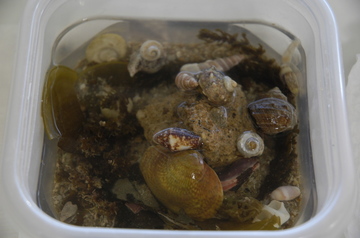
The hermit crabs were transformed from a home natural science project to temporary members of the family during our three days in Mexico. Emma named them all, and it was with great regret that she returned them to the tidepool on Friday.
Emma learned a little about life in the tide pool from this. We could all see the crabs foraging for food, establishing their position in the crab hierarchy, and co-existing with the other living things in the water. Each day the water needed refreshing, which was a good reminder of the needs of pets, too. I plan to point that out when the request comes for a puppy.
If there is an ideal pet for a few days in the Airstream, I will have to vote for hermit crabs again. They are silent, easy to care for, cute, free, hypoallergenic, they require no special equipment, and they have a built-in time limitation (once you leave the beach, they have to go).
We're back in Tucson for a while, back to work and once again looking at houses. While we were on vacation last week I had a chance to think about what we are doing and where we are headed. Here are a few thoughts I compiled while parked in Mexico:
Full-timing is not very much like camping most of the time. Most people who buy camping trailers look forward anxiously to the weekends and holidays when they can break away to a favorite quiet spot in the greenery of a forest, or in the blazing sunshine near a beach or in the desert. For them, the trailer represents the dream, and they can often get a thrill just to see it waiting in the driveway – a symbol of their freedom to come.
For us, living in the Airstream, every day is a day in the trailer, and although I still like to look at it, we have to make a special effort to separate the working days from the vacation days. In the past year I’ve been working a lot, six or seven days a week, and limiting my time off to a few hours each day in between sessions at the computer. My friend Dr. C pointed out that I have learned to be a supreme juggler, keeping work, parenting, wife, trailer maintenance, travel, blog, and various other projects all going at once, but the good doctor also pointed out that this may not be a healthy long-term strategy.
So part of the idea behind taking a full week to completely disconnect in Mexico was to regain perspective on the life we’ve been leading and to really enjoy some “camping” instead of just “living.” For us, camping means no obligations, no schedule, no email or cell phone. We just get up in the morning and do whatever feels right. Some days, that’s a walk on the beach, and other days like today, it’s writing down the reminisces or even defrosting the freezer.
That’s what Eleanor was inspired to do this morning, and I won’t ask why because an unspoken rule of our vacation time is to not question the why but simply go with the impulse. She doesn’t ask why some days I head straight to my computer to write down fresh ideas, and other days I go for a walk. Having to explain yourself is work, and we’re avoiding work, whereas if you really feel like defrosting the freezer in Mexico it may be your idea of fun at that particular moment.
Having had a few days to reflect without the barrage of emails that I normally respond to each day, I’m starting to see that some minor lifestyle changes are needed. That’s no problem, since our program and itinerary has been undergoing constant change since we started traveling full-time. Eleanor and I have been discussing the nature of our future life together for several months now, recognizing that we want to give Emma the option of “regular” school for a while at a fixed home base.
But it’s not easy to make the decisions. Emma may do better homeschooling than in public school. And back in December, Eleanor felt she was done with full-timing and would be happy to get into a house again. When we started looking at houses in earnest, the realities of house ownership struck hard (expense, obligation, worries, possible boredom). Suddenly these factors made another year in the Airstream look better and better.
I was wondering if this phenomenon was unique to us, so I talked to a few other full-timing couples who were getting “off the road” or had recently done so. They all reported the same thing: the prospect of sitting still was unappealing and one couple had even left their new house and gone back on the road for three months. In short, full-timing can ruin you. Home ownership no longer has the appeal that it once had, and can even feel like an unnecessary burden.
Still, a home base would be nice for practical reasons. Our compromise will probably be a very lightweight piece of real estate, either a condominium, small low-maintenance house, or even an “RV port” which is a sort of garage apartment that would store the Airstream and add extra living space.
One decision is certain: After we have the home base established we will continue to travel extensively. My job requires it, but also we love it. The Airstream gives us a second home, one with a huge advantage over the vacation timeshares and condos we’ve seen. The Airstream has wheels, and that means we have a second home anywhere we care to pull it. So most likely we’ll spend summers in the northeast, enjoying the fine weather there and avoiding the scorching heat of the southwest.
Speaking of scorching heat, blog reader Rita asked a question about how our fridge and other electronics fared in the hot weather we occasionally encountered in the past week. The short answer is that things like computers, cameras, etc., were fine. The refrigerator warmed up a bit, but running the new dual cooling fans we had installed at Roger Williams Airstream last January seemed to help. With the fans running and ambient air temperature around 100 degrees, the refrigerator stayed around 44 degrees, which is fine. As the weather warms up here in southern Arizona, we should have a few other chances to test the fans again.
It was a wise move to abandon Spring Break Land for Organ Pipe Cactus National Monument. We got a good night’s sleep for a change. I didn’t want to come back from vacation feeling run-down. And the advice I got about not staying in Puerto Peñasco turned out to be very wise. Even as we were hitching up in the middle of the day, the campground was emptying out of people over 30, and their rigs were being replaced by elderly trailers dragged in by tractor. The campground rents those old beaters to the college students, and our trailer was quickly being surrounded by them. It didn’t bode well for sleep.
Beside the Sea of Cortez the temperatures are much more moderate than in the Sonoran Desert heading north (which includes Organ Pipe Cactus National Monument). We left Puerto Peñasco in the low 80s with a slightly damp sea breeze, and 30 miles north when we stopped for lunch it was 108 and utterly dry. Fortunately, we found shade from a tamarisk tree in a roadside pull-out by a small ranch.

Lunch stop in 108 degree heat
At this point on Mex Hwy 8 there is a sister park to Organ Pipe, called El Pinacate y Gran Desierto de Altar, but everyone just calls it Pinacate (PEEN-a-kot-tay) for short. We stopped into to the visitor center at Km 51, but the gate was closed and nobody was in the visitor center. The door was open so I picked up some info and read the signs as best I could (they’re all in Spanish). Bert Gildart will be writing an article for the magazine about the Sonora Desert and I plan to contribute a sidebar about Pinacate. It’s an interesting place with a huge volcanic landscape, numerous cinder cones and lava tubes, a large bat population and much more.
Google Earth location of our lunch stop. Note to the west of our stopping point you can see the volcanic shield of Pinacate.
US Customs turned out to be no big deal. We waited in line for about 20 minutes, then had a one-minute interview with an amiable agent and we were on our way without even an inspection of the Airstream. The agent claimed to have seen Airstream Life magazine but I think he was pulling my leg.
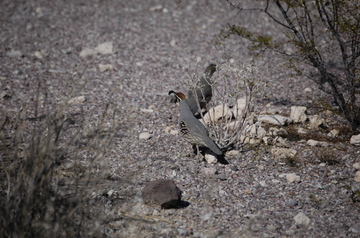
Gambrel's Quail in the campground
When I said in an earlier blog we’d be back to Organ Pipe I wasn’t thinking quite so soon, but we were all glad to be back, even with temperatures running about 100 in the afternoon and no air conditioning. It was just too obnoxious down in Puerto Peñasco, and this place is an antidote of peace and quiet. The only sound last night (other than the amusing ranger program, which was a sing-along of cowboy songs) has been the yipping of coyotes in the distance.
We pulled out some of our tricks for handling extreme heat. These include soaking our shirts in water, running all three Fantastic Vents, drinking lots of cold water, eating ice pops, soaking our feet in a pan of water, and napping. By sundown at 6:30 p.m., the temperature was a bearable 90 and after the ranger program it was 80 outside and dropping. With plenty of water, you can stay comfortably cool in almost any heat.
We have decided to pull out of Puerto Peñasco a day early. Frankly, we’re disappointed in it. We knew going in that it was a tourist town mostly for the benefit of Arizona residents, but we hadn’t anticipated how much they would have overrun it, and thus altered it.
The Spring Break mobs are becoming too much to bear. Their antics are taking the “family” aspect out of this town just as they have at southeast US beach towns. I think other people knew what was coming, because our campground got quite a bit emptier yesterday. Coincidentally, Ken & Petey left to spend a night at Organ Pipe instead, which in retrospect would have been a good move for us too.
During the day things are not bad, but as the weekend approaches the streets are getting more crowded and noisy with students roaring around in barely-muffled ATVs. It gets more lively in the evening, when the loud explosions from cherry bombs and firecrackers start. (This is such a problem that several campgrounds and beaches are posted against fireworks, but I have seen no enforcement.)
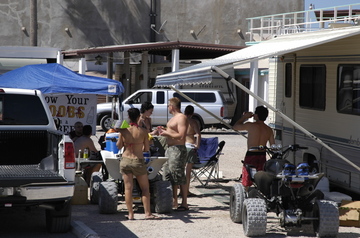
Our neighbors have erected a large vinyl banner that says, “Show Your Boobs – Win A Free Beer,” and set out a couple of large ice chests in anticipation. We’re not so prudish as to be bothered by the suggestion (I was mostly amused), but we were wondering if this was going to mean more noise right next to us. As it turns out, the males in question got no takers from the general public.
The music last night from the nearby bars rose to an unbelievable level, and gaggles of students were walking past our trailer all night, talking loudly. They also came and went using the extra-noisy rental ATVs. Sleep is harder to get each night. During one of our many nighttime awakenings, Eleanor was treated to the sight of a student barfing in the space next to our trailer at 4:30 a.m. This morning the seagulls arrived to clean it up.
I bought three pounds of jumbo shrimp ($20) from the fellow who drives by every day, and he told me this weekend would be worse. Two thousand students are expected to arrive. “This is not a weekend for you to be here, amigo,” he told me kindly.
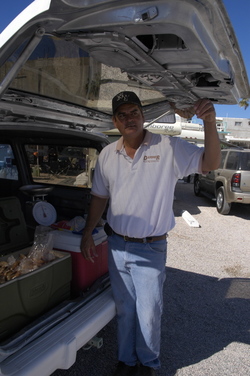
But the students are only part of the reason we’re going to head out. Puerto Peñasco is a pleasant enough town but it is being turned into something more like Cancun, with elaborate resorts along the water and plenty of programmed distractions (cruises, parasailing, fishing trips). I can see why people come to Puerto Peñasco, and it’s not a bad place, but it isn’t why we came to Mexico.
We want to explore Mexico to see the historic towns, ancient ruins, deep canyons, volcanoes, open-air markets, meet interesting people with different lifestyles, and to try local foods. The little authenticity this town has is being wiped out as quickly as possible, and the locals are mostly working on construction of new condominiums.
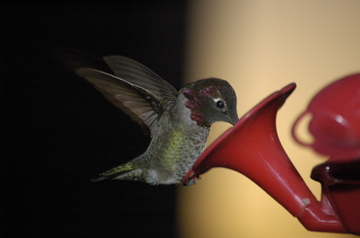
Hummingbirds in the campground
Still, the trip is not a failure. We’ve learned about this small corner of Mexico, and practiced a little Spanish. I got a break from work, and it has been relaxing (to the point of boring lately). Most importantly, we have gotten some experience with Mexican travel. I don’t think Puerto Peñasco prepares one for the “real” Mexico anymore than a ride on the flume in the Mexico pavilion at EPCOT does, but still the trip has served to give us a good trial run.
It is most ironic that people warned us about traveling in Mexico because of the perceived problems with Mexicans, and yet our disappointments have been entirely because of Americans. It’s also ironic that people said crossing the border would put us in a lawless zone, and in fact there seems to be more danger – at least in Arizona – on the US side of the border where the drug runners are hiking through the desert to make their drops.
We’ll be much better prepared for a long trip down Sonora either later this spring or next fall. Next time I will bring a few gadgets: a good quality surge protector that protects the entire trailer electrical system; a funnel that makes it easy to pour a 5-gallon water jug into the trailer’s water fill; a plug-in voltage meter that I can leave on all the time. Other than that, our normal complement of equipment is more than sufficient.
The funnel is because bottled water doesn’t pour into the nearly-vertical water fill opening on the trailer – it mostly spills. I miss the water fillers Airstream used in the 1970s that could easily be filled from a bucket. Eleanor and I improvised a funnel by cutting open a plastic milk jug, but I think we can come up with something better.
Buying purified water for our fresh water tank is a reasonable strategy, since it is apparently readily available, but it does make for expensive showers. It also gives us a chance to interact more with locals. For example, the water truck didn’t show up yesterday, and when I inquired at the office I found out that it only comes once a week, not daily as I thought. It was less than a mile down one of the town’s dusty roads to the water/ice plant, where I bought a 5-gallon jug using my pigeon Spanish (agua, grande, ¿cuánta cuesta?, gracias). In the final analysis, it was more interesting to buy at the agua purificada factory than it would have been to have the water delivered. Such moments open the door to meeting people, and in our travels we’ve found the chance meetings are often the best.
The scourge of Puerto Peñasco is condominium development. The north shore, called “Sandy Beach” is being completely covered by high-rise buildings, each offering a more “luxurious” living experience than the next. You can see the billboards along Rt 8 as you drive into town. These developments are primarily for Americans, and each one has a Sales Office, a gang of real estate agents, and a model home NOW OPEN, just like US condo developments.

Condos going up along Sandy Beach. Click for extra large view.
The pace of real estate development in Mexico is quite a bit slower than in the US, and apparently hazardous. All over town there are remnants of projects begun but not finished. Skeletons of steel framework, foundations poured over sand, lots cleared of their original modest structures but now accumulating only garbage, tattered and faded signs promising exciting new homes “coming soon” … all of these things suggest a boom-or-bust mentality, and to the skeptical real estate investor they spell Buyer Beware. It would be very dangerous to take advantage of “Pre-construction pricing”, given that the construction phase might never be completed. A few people that Ken & Petey have talked to are caught in exactly that bind. Their condominium is three years behind schedule. Mañana …
Still, at least half a dozen major projects are underway on Sandy Beach, and several are already open. Nearby is Playa Bonita RV park, one of the nicest in town, similar to Playa de Oro but facing a nicer stretch of beach and some frankly beautiful views.
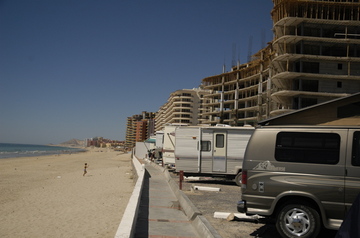
Front row at Playa Bonita RV Park
I’d stay in the park, but I can’t see buying one of the condo properties. As these developments go up, they emphasize the boundary between the “haves” and the “have nots”. The road to the resorts may be gated, paved, and lined with palm trees just like in Florida, but just a block to either side the streets are still made of sand, lined with roofless shacks, trash, mongrel dogs, and other indicators of a poor people. It's a startling disparity of wealth that is sealing off miles of their beach for the exclusive use of Norteamericanos.
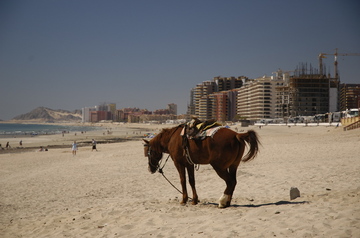
Rent a horse at Sandy Beach
Google Earth location of Sandy Beach.
To the south of town, along Los Conchos Beach, development has taken the form of miles of single-family residences clustered along a narrow strip of coastline. Driving through this area is almost surreal because of the strange architectural styles. Most of the houses have a “Mediterranean” influence, but odd visual cues are everywhere. One house brags both Roman columns and Russian minarets. Others are a hodge-podge of Greek, Spanish, and Turkish styles.
The entire neighborhood is accessible only by hard-packed sand streets, and since most of the houses are rentals or “fractionals” (a form of timeshare ownership), the neighborhood is transient and sterile. But for a pure getaway, just to hang with the family and play on the beach, it looks good. The view to the calm blue water of the Sea of Cortez is admittedly beautiful.
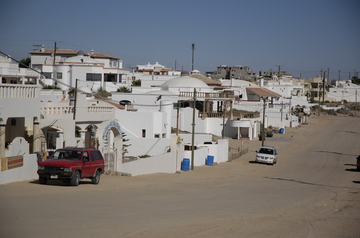
Google Earth location of Los Conchos Beach area.
Do we feel safe? Yes, we do. There’s much more to be concerned about, crime-wise, in New Orleans, Miami, or even tiny Ajo, Arizona. This is not a border town, and the drug problems that go with borders seem to have bypassed Puerto Peñasco. The beach is lightly populated with families playing games on the sand, and college students admiring each other from beach towels. The RV park is full of happy Americans walking around in towels, and not one sign of a criminal element has appeared. We are much more comfortable here than we would be camping in many US downtowns.
The worst problem seems to be badly inebriated college students. Puerto Peñasco apparently wants to reach the Ft. Walton/Destin standard of Spring Break, and the town is getting there. Billboards and signs on the restaurant/BARs advertise to their prurient interests (binge drinking and wet t-shirt contests), and so from late afternoon onward it’s not hard to find evidence of the unfortunate results. Yesterday Ken was favored with a view of a student vomiting next to a trailer here in the park, while the student’s friends offered unhelpful comments (“Hey, you gonna be OK, man?”). One hopes that it was his own trailer he was tossing cookies on, and not one belonging to some poor visitor from Colorado.
There is a feeling of “anything goes” here, but it’s really not true. They do rent ATVs to college students and let them roar through town on them, helmetless and belching, but the police are still visible where needed. At night the scene is probably horrific with crowds on the streets and various mating displays rivaling Mardi Gras in the French Quarter, but at that time we are back in the Airstream enjoying dinner while the cool sea breeze blows through our open windows.
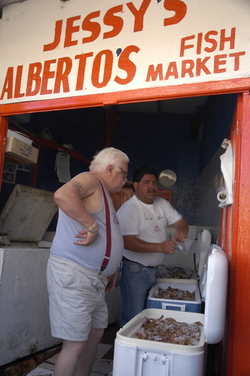
Selling shrimp in the Old Port
The Old Port is the only part of the town that is reminiscent of a border town like Tijuana, Ciudad Juarez, or Nogales. There you’ll find the usual border town shops carrying pharmaceuticals, tacky t-shirts, pottery, and other trinkets. But even still, it is nicer than the border towns. The open-air pescaderia has beautiful shrimp, clams, and fish, and friendly but not aggressive hawkers selling them. We would have bought a bunch of seafood, but this morning I bought a pound of jumbo shrimp for $7 from a vendor who was driving through our RV park, like the fresh-water vendor.
So we’ll grill the shrimp tonight and then go buy something else fresh tomorrow. In fact, since US Customs doesn’t seem to be concerned about Mexican seafood, we may load up on shrimp to bring back to Tucson, on our last day here.
Google Earth location of Old Port and photos above.
We were warned about coming to Mexico. “I wouldn’t take my family there!” “You’re crazy to take your car/Airstream into Mexico!” “You can’t take guns there!” “What about the mordida (bribes)?” “Have you had a Hepatitis shot?” And of course, the perennial favorite … “Don’t drink the water!”
The nay-sayers were out in force in the months before we came here. A dozen conversations we had with well-meaning friends can be summarized as simply, “Don’t go. It’s too dangerous.” But none of these people had ever camped in Mexico, indeed, few of them had ever crossed the border.
Many other people said “You’ll love it!” and recommended places to go. All of these people had been to Mexico numerous times. Many of them were in their 60s and 70s and felt safe traveling alone. Quite a few spent months camping in Mexico each winter. We chose to listen to these people because they had the benefit of actual experience.
We did not find a single person who had a first-hand tale of “banditos” or violent crime, and very few had ever gotten sick. It turns out that the banditos are a piece of folklore, about as relevant as tales of Billy The Kid to today’s traveler of Mexican highways.
The two books I consulted on the subject were also reassuring. “Traveler’s Guide to Mexican Camping” said, “People in border campgrounds will warn you not to cross into Mexico because there are banditos, dishonest cops, terrible roads, and language and water problems. The one thing you can be sure of when you get one of these warnings is that the person has not tried Mexican camping for him/herself.”
The “People’s Guide to Mexico” went into even more of a tirade on the subject, too long to quote here. But it was clear from our research, and our recent days in Organ Pipe Cactus National Monument, that we were not about to experience anything nearly as bad as the hazards and crime found on the US side of the border.
Puerto Peñasco is not part of the deep innards of Mexico. It’s a small town on the eastern shore of the Sea of Cortez, only 65 miles from the border. It is also known as Rocky Point by Americans, although that’s not its proper name. Being so close and convenient to the USA, it’s a huge spring break draw this time of year, and so popular with Arizona residents that it is sometimes referred to as “Tucson Beach.”

It hardly feels foreign, with the thousands of US residents filling the RV parks, hotels, restaurants and beaches. Everyone in the tourist-related businesses seems to speak English, dollars are accepted in many places, there are lots of English signs, and services in the RV parks are pretty similar to the US standard. It’s an easy place to visit even for someone who has never set foot outside of the US or Canada before.
Being a tourist town that caters to college students on spring break, most things are geared to serve clueless Americans. We overheard a group of them coming through Organ Pipe Cactus National Monument, telling the ranger they were headed to “that Mexico place.” When she asked which place, they said, “You know, that place in Mexico.” With that sort of knowledge and preparation coming across the border, you can imagine the patience the residents of Puerto Peñasco must have to deal with their customers.
I like to dive into the local scene in a foreign country, and the easiest way to do that is to join the local economy. Hit a grocery store, drop in on the market that doesn’t cater to tourists, or buy lunch from a street vendor or small off-the-beaten path bakery. Today, after Ken & Petey bought us a nice lunch at Playa Bonita Resort on the beach, where the menus and service were in English, I went out to see if I could do a little local business.
My short trip started with a stop at the local Banamex for some pesos from the ATM. Even though the machine only “spoke” Spanish, ATMs are the same the world over, so this was no challenge at all. However, it was interesting to observe the people using the ATM ahead of me: a security guard from a resort, a college student trying to get a cash advance on his US credit card, and an American couple who didn’t realize that in Mexico the “$” sign is used to denote pesos. Thus they were a tad confused that the machine would dispense as much as $5000 at a time. (To approximately convert pesos into dollars, divide by 11.)
I spent 300 pesos at the local Telcel store, buying a Telmex pre-paid SIM card for my spare GSM phone. GSM is the type of cell phone network used most widely in Mexico. Although US cell phones will work in some places, the technology they use is not as widespread. My US-based Verizon phone, for example, reports only an analog signal and not much of that. The Telmex SIM gives my GSM phone a Mexican phone number, so we can make calls in Mexico as inexpensively and easily as the locals do. This will be useful on future trips.
The final stop was to put 100 pesos of gas in the truck. Since Pemex stations sell in liters it can be confusing to determine how much gas you’ve bought, but with a calculator it’s pretty simple to do the conversion. How much gas does 100 pesos get you? Answer: Not much.
The fun part of doing these little errands is that nobody I encountered spoke any English, and so I was forced to communicate with universal tools. These include a smile, a polite and self-deprecating demeanor, as many words of the local language as I can conjure, hand gestures, and endless patience. With these tools I have successfully communicated with speakers of French, Italian, Spanish, German, and Portuguese, and even Czech. I don’t speak any of those languages. It is a very satisfactory feeling to manage to conduct even a minor transaction (such as buying gasoline) with only a smile and a few words, and I think the person on the other end of the transaction usually feels the same way.
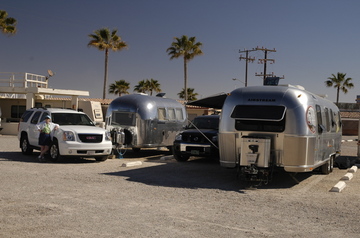
Our campsite next to Ken & Petey at Playa de Oro
Google Earth location of Playa de Oro campground.
There are several RV parks right along the beach, and we’re in one of them: Playa de Oro. This place is located south of the Old Port, near a lot of tourist “restaurant-bar” spots (emphasis on BAR, especially this month). The park is 320 tightly spaced full-hookup sites on a crushed shell surface and no view except on the beachfront sites. At night the restaurant-BARs turn on their music and we get a free, somewhat muffled, concert of dance music until about 2:30 a.m. Last night it was noisy but not unbearable, and we managed to sleep through it.
We don’t know if the water in this campground is safe to drink, but we arrived with a full tank (39 gallons) of fresh water and it should last for the four days we will be here, with conservation. If not, a vendor drives by daily in a pickup truck loaded with 5-gallon jugs of agua purificada, and when he honks his horn all we need to do is wave to him and buy a jug, just like we would for an ice cream truck. As a result, we have not connected to the water spigot at our site.
Similarly, we have avoided using the AC power. I tested the power outlet for correct wiring (ground, polarity, hot/neutral) using the simple tester that Airstream provides with every new trailer, and it passed. That’s more than I can say for some US parks, most recently one in New Mexico we stayed at. However, my voltage tester is dead, so I can’t verify whether the current is in the safe range for running certain appliances, like the air conditioner. Mexican campgrounds have a reputation for wildly fluctuating voltage, sometimes dropping during the day and rising at night, or spiking without warning.
As in other desert locations, there’s endless sunshine, so our strategy is to simply not plug in except for a few minutes in the morning to run the coffee pot. With the cool sea breezes we don’t need air conditioning anyway, and the solar panels are supplying more than enough power each day to fully replace what we use at night. My laptop, which comes out only once every other day to record my musings, is running off DC power and is thus insulated against variances in the AC voltage.
For the various comforts and liabilities listed above, we are paying $19 per night, which is very reasonable by US standards for a spot about 200 yards from the beach. In Fort Myers Beach, for comparison, a similar site cost $52 per night, although the beach was prettier. The beach is not bad here but certainly not up to the gorgeous sugar-white standard of the Florida barrier islands, and not quite as nice as the beaches north of town, which are wide, shallow, and uncrowded even during Spring Break.
The water is reasonably clear, if somewhat cold, and the beach is a coarse tan sand which at low tide reveals shelves of the underlying volcanic basalt. Anyone on the beach will soon encounter all types of beach vendors, selling “Cuban” cigars, jewelry, trinkets, and other assorted junk. Not one so far has offered us the stuff one might expect on the beach: cold drinks, sunscreen, parasols, folding chairs, inflatable beach toys, or kites.
Organ Pipe Cactus National Monument has changed lately and not for the better, I’m sorry to say. Continuing border problems and the threat of violence from drug-runners has caused the park service to shut down all back-country hiking trails and all the border roads in the park. This effectively eliminates the majority of access to the park’s many subtle delights. Old mines, historic ranch sites, even the tiny habitat of the endangered Quitobaquito desert pupfish – all are off limits now. Now it seems that visitors to the park have joined the desert pupfish as an "endangered" species needing protection.
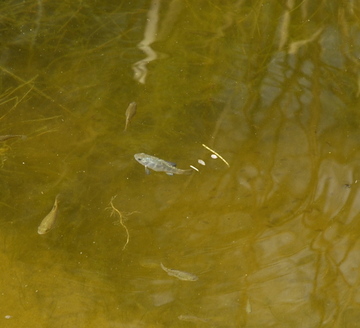
The endangered Desert Pupfish. Note the male fish is blue.
A year ago the border was a problem too, but only a small portion of the park was closed at that time. The most recent closures have changed the essence of the experience at Organ Pipe. It is still a peaceful and beautiful place, but the tension of border problems is an ever-present cloud. The rangers have to spend too much of their time explaining why you shouldn’t explore parts of the park – something that must really frustrate them. The Visitor Center is named for a ranger who was shot to death by criminals who crossed the border.
A short distance from the campground you can find large blue flags on a tall pole, indicating one of several humanitarian water stations. These are put in the park to aid the everyday “UDAs” (Undocumented Aliens) who attempt to hike 80 or more miles through brutal desert conditions with completely inadequate preparation. Many of them have no idea what conditions they will face, when they cross the fence. Once they’ve realized their mistake, rather than dying in the desert they can get water and wait for help (which will include deportation).
Fear is now a factor in the park. The park visitors, the rangers, the border control agents, and the UDAs all feel it. Hiking in the park in years past we would have looked for rattlesnakes, gila monsters, cactus wrens, or kangaroo rats. Now, will you see any of those or will you be too busy looking for an armed drug runner, a desperate family without enough water, or a giant pile of trash left by border crossers long since departed?
I don’t mean to pick on Organ Pipe Cactus National Monument. It’s still a wonderful park and it doesn’t deserve the problems it faces. We’ll come again and enjoy it again. But the huge changes we’ve seen here in just one year reminds me that all parks are subject to change as a result of environmental, political, climatological, or even geographical changes.
When you visit one, try to experience as fully as your time allows. Next time you visit, things may have changed, especially in border parks. During our first visit to Big Bend National Park, we were able to freely cross the Rio Grande to have dinner in Boquillas Mexico. Now that’s illegal. In Hawaii Volcanoes National Park, lava flows can ebb to barely anything, so if the lava is visible, it’s worth staying until dusk to see it!
One year I planned to visit Cabrillo National Monument during a business trip to San Diego, but my free day was September 12, 2001, and the monument – being close to a naval base – was off-limits for a few panicky days. It was four years before I got another chance at it.
In Sabino Canyon (part of the Catalina National Forest in Tucson), floods during the last monsoon season wiped out trails that we could have hiked the previous year, if we’d taken the time. We’ve accumulated dozens of other examples, too. The point is that even in national parks, where the goal is preservation for future generations, nothing is static. Seize the day!
The good news is that Organ Pipe is not heavily visited, so seekers of peace and quiet can still find it here. The RV campground in Organ Pipe Cactus National Monument has no hookups. The park also takes no reservations, cell phone coverage is marginal, and the park is far from population centers and services. These factors keep visitation to the campground down.
Last year we had to leave the park earlier than we wanted because the furnace chewed up our power at night and even running the generator for the maximum four hours allotted each day wasn’t enough to keep up. This year we have solar panels, like most of the other residents here. Solar is ideal for places like Organ Pipe because it silently recharges the batteries all day, not just during the posted generator hours, and there’s plenty of sunshine here. We have had more than enough power to fully recharge the batteries every day.
Next to us are Richard and Norma, who coincidentally I met last year at the International Rally in Salem OR. Richard is a woodcarver, and his trailer has several delicate hummingbird carvings hanging from it. He carved one just for Emma, too, from a single piece of wood. It’s a beautiful thing, and just the right size and weight to be a good full-timer’s souvenir. We’ll find a place in the Airstream to hang it.
Two spaces down are Bert & Janie, and today Ken & Petey showed up in their 1964 Airstream Globe Trotter, so that makes four Airstreams in our immediate area.
Our Google Earth campsite location in Organ Pipe.
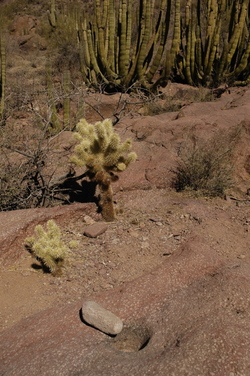
A grinding hole, cholla cactus, and organ pipe cactus
Today Bert recruited me for a hike by Alamo Canyon. Janie came along, but Eleanor stayed back because Emma was still sleeping. The hike started about 10 miles north of the campground (and three miles down a bumpy dirt road), following a perennial stream to an old one-room ranchhouse and corral. Along the dry streambed there are ancient Native American grinding holes in the bedrock, fifteen by our count. These are quite possibly thousands of years old, and were used to grind up mesquite seeds and other gatherings. We’ve encountered these in Big Bend National Park and other places, but they always are awe-inspiring and make me think about how the people before us managed to live here.
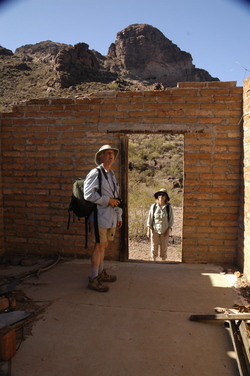
Bert & Janie explore an abandoned one-room ranch house, Alamo Canyon
This evening Bert went back out to Alamo Canyon to shoot a particular night scene. He wanted to capture saguaro cactus against the Ajo Mountains with the stars creating circular trails overhead. This picture requires a tripod, very clear skies, a view of the Polaris (the north star), a cable release, and a camera that has a “Bulb” setting that holds the shutter open indefinitely. He came back successful, with a gorgeous 15-minute exposure that appears on his blog. I wish I’d tried it too, but we hung back to attend the 7 p.m. ranger talk about Organ Pipe’s sister park in Mexico, called Pincate.
Tomorrow we will disperse. Ken & Petey will follow us across the border to Puerto Peñasco, and Bert & Janie will begin the long trek back to their home in Montana. They’ve been on the road for nine months, ever since we saw them at their home last July. It’s time for a break for them. I hope they’ll be on the road again this fall so we can have more hiking and bicycling trips together.
Although the blog is “officially” paused for a few days, I find that after 17 months of daily entries I am compelled to write down some of my observations, lest I forget them. Things are happening so quickly and with such vibrant color that I can hardly keep track of them all; Both visual stimuli and personal encounters are engaging and exciting now that I am free of work concerns for a week, and I am finding that I notice more details. Even the tamales Eleanor made last night seemed to be full of subtle flavors, and so I ate more slowly and anticipated the next course: a slice of Dutch Apple pie left over from our visit with Mike & Sam last week. This is the delicious difference of vacation.
Along the road east from California there seemed to be more to explore than when we went westward, too. Coming down from Octotillo Wells we passed at least a dozen wonderful-looking spots for boondocking. You could spend a year in Anza-Borrego Desert State Park and never spend a night in the same place. I wish we had time to try them all.
Then the shimmering blue stripe of the Salton Sea appeared. At first I thought it was a mirage, because I’d heard the Sea was slowly evaporating (which it is), but the Sea remains quite large. A lot of new development is underway on the west side, replacing what had been a very quite section of uninhabited desert. I don’t know who wants to live there beside a vanishing and overly-salty artificial lake with environmental problems, but apparently there is demand.
Along I-8 the highway passes through strange contrasts: stark desert bordered by canals filled with fresh water, then lush green landscapes, then desert again. In places the green is so widespread and rich with carrots, avocados, broccoli, and grass that it appears to be the norm, but then I would remind myself that every inch of that green is courtesy of irrigation. Without the canal system bringing water there would be little other than cactus.
There are many more things we’ll want to explore off I-8 later. There is a massive area of tall sand dunes where the four-wheelers play, parking their “toy hauler” RVs in flat spots near the highway. There are so many that they seem to form their own communities on the weekends. There is an interesting petroglyph site, and the RV mecca of Quartzite. There are Native American historical sites, and small towns.
In Yuma we stopped at a grocery store, and got a knock on the door from a couple that told us, “We’re one of the very few people full-timing in a Safari 30 bunkhouse!” I said, “Well, now you’ve met the other people full-timing in the Safari 30.” Turned out they had read the blog, knew about details of our trailer like our disc brake upgrade, and had subscribed to the magazine. This sort of chance meeting is happening more to us lately. I think we’re becoming notorious.
Let me try to convey where we are now. You drive along I-8 to a tiny truckstop town called Gila Bend. Pick up fuel there, because it’s going to be a long way before you see it again. From Gila Bend, take the lonely two-lane strip called AZ 85 straight south to Ajo, 60 miles away. In Ajo you can find some groceries, food, and gas, but only if the grocery is open (it wasn’t on Monday). Ajo is a tiny land-locked copper mining factory town, but the copper mine is closed and now most of the residents work for the Border Patrol.
Continue south through the intersection – hard to call it a “town” – called Why (and the “Why Not Café”), and about 25 miles later you’ll reach the formal entrance of Organ Pipe Cactus National Monument.

The Ajo Range
Two things happen as you enter Organ Pipe Cactus National Monument. First, the cactus starts to change to a mixture of saguaro and organ pipe, with other common Sonoran desert plants: ocotillo, creosote, prickly pear, palo verde, and cholla. Along the eastern side of the road the view is suddenly dominated by the jagged purple volcanic ridges of the Ajo Mountains, which look stunning in the late afternoon sun.
Second, you may encounter a Border Patrol checkpoint. They aren’t interested in people heading south, but it is commonplace to stop for a check when heading north. Usually this entails nothing more than a quick question from the agent before they wave you onward.
We arrived at Organ Pipe near sunset, so there was just time to dump the tanks, fill up with fresh water, and run over to Bert & Janie’s trailer, just a few spaces away. Emma insisted on a “super quick, quickest bike ride ever!” so we quickly unfolded the Birdy Bikes and pedaled around the campground to the setting sun.
It is warm here, as I had hoped. Last time we were here (January 2006) the nights were around 40 degrees with a strong cold wind. Now, in March, it is running 80-90 during the day and dropping only into the mid-60s at night. Bert & Janie have been sleeping with all windows and entry door open, with a fan running. Janie warned me not to come by their trailer late at night because she had the bear spray ready for an intruder.
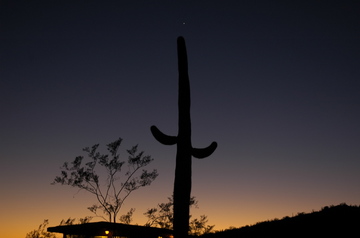
Saguaro cactus pointing at Venus
It is rare that we get to sleep with the windows open, because it is usually too cold, too humid, too smoky from nearby campfires, or there is too much pollen. But in the dry desert it is remarkably comfortable, so it was with some glee that I opened all the windows for a night of really fresh air. Organ Pipe Cactus National Monument offers no hookups, so there is no option for air conditioning at night, which is actually good since with AC we would have had the trailer sealed all night and not enjoyed the fine night air. We’ll do the same again tonight.
Finally, the Summer magazine is ready for layout, which means I can relax and enjoy the park! Anza-Borrego is a beautiful place, and this is a great time of year, so it is tragic to waste it sitting in the trailer worrying about work. I've tied up the remaining loose ends that I can, and placed all other projects on hold for a week. Whatever problems remain to be solved will just have to wait for a while. I'm on vacation.
I was very happy for Bill & Larry since their first boondocking experience was very successful. They seemed to have no trouble grasping the techniques of water and electricity conservation, and had no fear of being "out in the boonies", away from a campground. In fact, Larry mentioned to me that when they bought their new Airstream, this was the sort of place they had envisioned camping -- with few people around, quiet and peaceful.
They packed up and headed home mid-day, but we and Rich C had already headed off for a bit of exploring in the southern end of the park. About 20 miles away, and three miles down a bumpy, narrow, dirt road, we found the trail to the Marshall South homestead. This family tried to live off the land on the top of a hill in a very remote and difficult area, back in the 1930s.
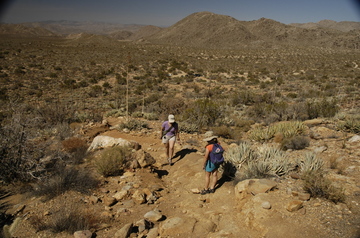
Hiking up the trail to the house
Even today the spot is inhospitable. There is no water -- the family used a water-collection system and cistern. All supplies had to be transported via Ford Model T, then carried up a steep rocky trail for a mile. Temperatures in the summer routinely exceed 100 degrees. They lived in a homemade adobe house with no amenities at all, for 16 years, until the wife quit and the family broke up.
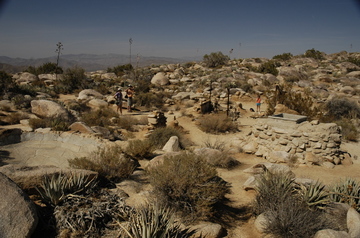
The dissolving remains of the South homestead
We did another short hike as well -- the Narrows Earth Trail -- since it wasn't particularly hot. (Temps ran 78-88 depending on altitude.) But if you do some hiking in the desert, keep in mind that even on a moderate day you'll require a lot of water.
By late afternoon we felt like taking it easy, so we headed to downtown Borrego Springs for a Mexican dinner. It was a perfect time for eating outdoors. In Borrego Springs, the tall mountains to the west block the late afternoon sun, so the town gets a welcome shade around 5 pm (this time of year), and it immediately feels comfortable. The downtown has a certain funky feel, with a few old-fashioned neon signs and small-town businesses, and a big centerpiece called "Christmas Circle" where the town provides a big green lawn and palm trees.
This will be the last daily blog entry for a few days. We are heading to Organ Pipe Cactus National Monument today, in southwestern Arizona, to meet Bert & Janie, and Ken & Petey. Organ Pipe is a wonderfully remote desert park where there is neither cell phone service nor Internet access. We will be completely cut off from the instantaneous communication that has influenced our travels for the past year.
Organ Pipe has no hookups either, which means you need solar or a generator if you want to stay for long. We had to leave the park early last year for lack of adequate power, but now we have two solar panels and four batteries. We've already been unplugged for two days and two nights, but with the constant desert sun we are in no danger of running out of power.
We'll spend two more nights in Organ Pipe, hiking and taking pictures with our friends, and then head into Mexico for four nights. In Mexico we might have some limited Internet access, but I am going to be taking a break from the blog & from business, so most likely I will not update this blog until we return to the USA on March 17 or 18. Check back once in a while, or make a note to come back on March 17 to see how we fared in Mexico. We should have lots of stories and photos to share with you.
We moved out of the Palm Canyon campground today to do some desert boondocking. Here in Anza-Borrego, there are places where you can camp indefinitely at no charge. One such place located just outside the Borrego Springs city limits is known as "Pegleg". We hitched up today at noon and headed over to become desert rats.
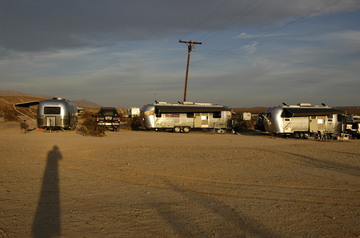
Rich C, and Larry & Bill also came over, so we have our three Airstreams parked together for another night. This is a funky spot. Pegleg is named for Pegleg Smith, a teller of tall tales and a prospector, who supposedly found a gold mine around here decades ago. Of course, nobody knows where it is, but everyone would like to find it. If you want to find it, just add 10 rocks to the pile here at Pegleg.
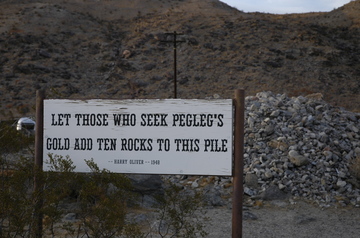
Rudy, a fellow Airstreamer parked nearby, is like many others who come back here year after year. We first met Rudy in January 2006 and he told me about this spot. Ever since, I've wanted to come back to check it out ... and wouldn't you know, Rudy's parked right up the slope. He came over tonight to tell us about his trips to Baja.
It was hot again today, with temperatures in the upper 80s and strong sun. Of course boondocking means no air conditioning, but with the natural breeze, the awning, and our three Fantastic Vents it was very comfortable. In this part of the desert the temperature quickly moderates as the sun sets, and by 5:30 it was perfect for Emma and I to take an exploratory bike ride around the area.
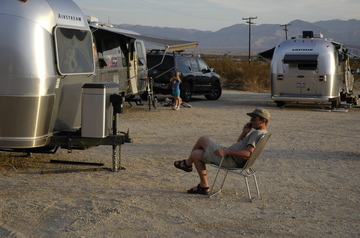
By 7 pm, right after dinner outside Bill & Larry's trailer, a strong wind came up which encouraged all of us to take the awnings down. It is my rule of thumb that the awning should come down at night, since whenever I neglect to do so there is inevitably a high wind at 2 a.m. Too many times I have been outside in my pajamas taking down the awning in the middle of the night!
Once again this evening the bright stars filled the sky and if possible they were even brighter than before. Out here we are clear of even the small amount of light generated by Borrego Springs, although over the mountains a dim glow can be seen from San Diego. We all stood out there admiring the incredible view. I think we're all happy to be out here, feeling independent and in a real camping mood, eating outside, seeing the stars, and enjoying the quiet.
Google Earth location of Pegleg.
I needed to spend the day in the trailer working, which required considerable discipline since it has been an absolutely beautiful day outside. Best I could do was open all the windows and let the warm desert breezes fly through the trailer. Eleanor and Emma at least got out a bit, heading into town to do laundry and talk to some of the locals.
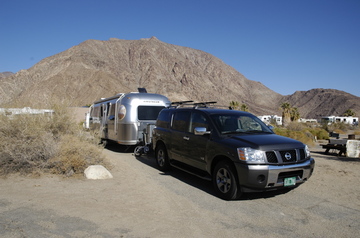
While working, I got the following email note:
Hey there, Rich, Greetings from the Komfort 5th wheel across from you! We've been using your WiFi since last night, so thought I'd better pipe up and say thanks. My husband Geno and I RV about 7 months out of the year. He's cycling up Montezuma Pass right now. Instead of working, I've been enjoying your site, the IIM site, the Digital RV forum, etc. If it's OK, we'll plan to stop by to meet you this afternoon. Thanks again, Pat
It's strange to meet people as a result of providing free wi-fi, but hey, whatever works. Pat and Geno popped over after lunch and turned out to be very nice folks. Wish I'd had more time to chat but work still needed to be done, and even now (at 10 pm) there's more to be done.
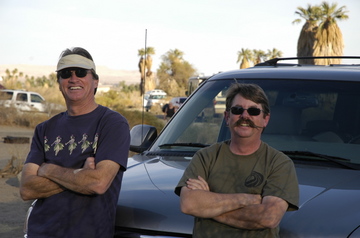
This afternoon we got another visit, from Mike and Sam. We last saw them in Salem, OR at the International Rally. Their wives were unavailable today so the guys drove nearly 2 hours over the mountains from San Diego just to hang out for a couple of hours with us. And they brought us a Dutch Apple pie from Julian Pie Company, which pretty much puts them on our "A List".
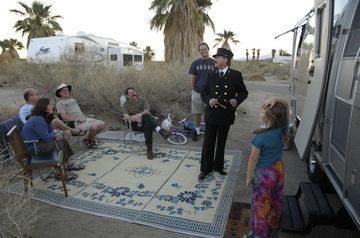
At 5 pm, Bill put on his lighthouse-keeper's uniform. He does docent work at Cabrillo National Monument, recreating the persona of Capt. Robert Decatur Israel, who managed the Old Point Loma Lighthouse from 1871 to 1891. Since he also looks a lot like the conductor from "The Polar Express", he did a little routine for Emma based on that story. Between him and Emma it was hilarious. At the end, he presented Emma with a copy of the book and a little silver bell. If you've read the book or seen the movie, you'll know what the bell symbolizes.
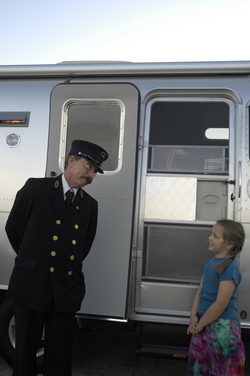
Our month at the park in Tucson is up, and rather than extend we've decided to head west to California for a few days. We'll go back to Tucson later, after I finish the magazine and take a littlIt e vacation time.
Buying a month at a time in a campground is a new experience to us. Generally when you do that, the campground charges extra for electricity. We used about 384 kwH in the past month, which came out to $45 for the month. I was a bit surprised it was even that much, since we were gone for about 12 days. Still, it was less than our deposit, so I got $5 back upon departure.
It was a long pull along I-8 to Borrego Springs, CA, 386 miles in total. Much of I-8 has little to recommend it, but there are bits of scenic beauty to be found, especially as the route heads into California. Our route took us into the heart of the Imperial Valley, where incredible amounts of vegetables are grown in the desert courtesy of massive irrigation projects and canals. Brawley is a small city in the center of this farming valley, which looks like a decent place but seemed to have a constant smell of cow manure.
Around 5 pm we pulled into Borrego Springs, a town surrounded by the very large Anza-Borrego Desert State Park. This is one of our favorite places. You can see our blog entries from last January for more information about the park; just scroll down to the Archives in the left column and click "January 2006".
Rich C is here, as well as our friends Bill and Larry in their new 23-foot Safari, and a few other folks in Airstreams. We had a quick bike ride through the park, and then a very mellow get-settled dinner courtesy of Larry this evening, and wrapped up by sitting outside watching the stars. The air is very clear here, and the stars are bright. Emma spotted Orion's Belt instantly, and then the Big Dipper, and I showed her the Milky Way -- something the folks in Palm Springs or San Diego probably never see due to light pollution in those cities. Anza-Borrego is a special place for us and it's great to be back.
Work was going so well this morning until Bert showed up around 11 and said, "Let's go for a hike!" It was a beautiful day, heading into the 80s, and my resolve was weak. So Emma and Zoe the stuffed cat and I threw on our boots and joined Bert & Janie on the Douglas Spring Trail of Saguaro National Park.
(For background, you should know that Zoe the cat comes with Emma on every major hike. She rides in Emma's backpack with her head sticking out. Zoe has seen more national parks than some national park rangers. She's a very lucky orange stuffed animal.)
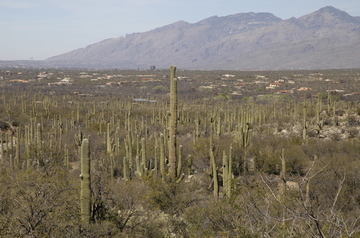
Saguaro forest and the Santa Catalina mountains
Douglas Spring Trail to our destination is 5.2 miles roundtrip, with 1100 feet of elevation gain, "strenuous and rocky," according to the official park guide. At the trailhead someone warned us that people had spotted "snakes on the trail" this morning, to which we all grinned and thought, "Bonus!" We've been hoping to spot a rattlesnake from a safe distance, but thought it was too early in the season to have much of a chance.
So I reminded Emma of what to do if a snake appears or is heard (more likely), and we headed up the rocky trail. No snakes, but plenty of saguaro forest, early desert flowers, and heat. Our greatest challenge was making sure we were all well covered with sunscreen. It was a long slow slog up the slope and I was glad I'd brought a pair of water bottles for each of us.
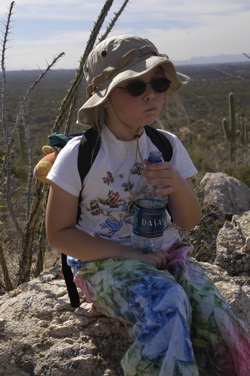
Ultimately it reached 85 degrees in blazing sun, but of course with the extreme aridity the sweat would dry on our bodies in seconds. We found a shady spot by a tiny bit of water with cool rocks and made that our turnaround point for the hike. Sitting on the rocks was enough to make me extremely comfortable, but Emma went the extra mile and dipped her shirt and hat in the water, wrung them out, and put them back on. Her cotton shirt was dry before we got back to the truck.
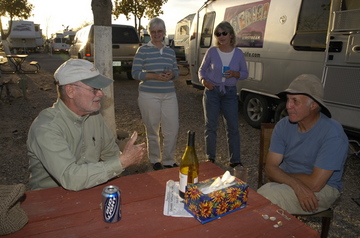
Charlie, Lynn, Janie and Bert outside our trailer
While were gone we found that Mike & Tracy had come by, but we missed them. (Eleanor was out grocery shopping.) But not long after we arrived back at camp, our friends Dr. C and Lynn showed up, and so we gathered up Bert & Janie and went out for dinner.
I was particularly happy about this fortuitous meeting because Dr. C and Bert have both been contributors to Airstream Life since the very beginning of the magazine, and I had not until now had the chance to introduce them to each other. We're all leaving Tucson this week, so this was our only chance to hang out together. Dr. C and Lynn are heading back to their home in the frozen north on Friday, and Bert & Janie are heading down to Organ Pipe Cactus National Monument where we will see them on Monday.
To see Bert's recent blog entries about our hikes in Saguaro, see www.gildartphoto.com/weblog
E&E are back in the Airstream, and that means the fun begins anew!
We all tried to sleep in this morning, since their flight was a little late, and we ended up getting home around 12:45 a.m. But with the ladies on Eastern Time, "early" was earlier than I would have chosen. Oh well, at least my bed was warmer than it has been in weeks.
The "bad" OPD valve on our propane tank that I mentioned yesterday turned out not to be bad at all. Too bad I had to drive across town 30 minutes to find out. I was given bad information in Texas by another propane man, apparently. Now the tank is full and mounted back on the trailer, so we're ready to head out into some very quiet places in the desert for a little vacation, starting Wednesday.
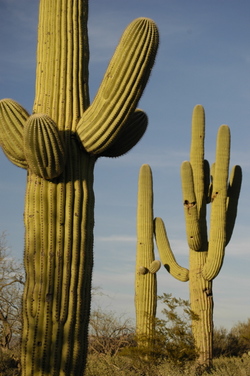
Today we had a warm-up, hiking in Saguaro National Park (east side) with Bert & Janie. (Eleanor, still afflicted with a cold, stayed home.) For the past 36 hours we've been whipped by very dry winds, with the relative humidity dropping into the single digits, but finally they calmed and the sky became the sort of stunning blue that the desert is known for. We grabbed the cameras and headed out.
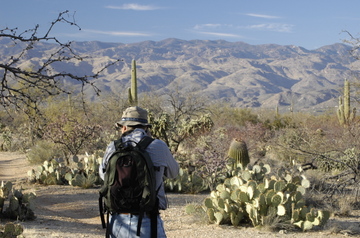
Our two short hikes weren't long, since we started around 4 pm and paused frequently to check things along the way (cactus, birds, washes, views). Hiking like this, you often discover things about your friends. Conversation seems to flow easily when hiking. Today, for example, I discovered that Bert was carting around a sample of alligator poop in his camera bag, a souvenir of Shark Valley in the Everglades. Apparently he's something of an amateur scatologist. The sample will be used for some sort of naturalist "Show & Tell" later. I wish I could be there to see the faces of Bert's audience.
I have been thinking about whether Eleanor and Emma will make it back tonight. I woke up at 6:15 a.m., before the sun rose, and since I was up I decided to head right to the computer and get some work done. The next thing I knew, it was 12:30 and I was starving, thirsty, and still wearing my pajamas. Sometimes that happens when I get absorbed in work.
But at least I got a lot done on the Summer magazine, and being busy, I hadn't been fretting all morning about the flight tonight. For the past day my concern has been whether Eleanor and Emma were sufficiently recovered from their colds to fly. Emma seemed OK but it's hard to tell with her. Eleanor is definitely still sick but could equalize her ears with a Valsalva Maneuver this morning, so I knew she'd be OK on the airplane. Even still, I've been apprehensive, probably because we've had such rotten luck flying lately.
By 2:30 I was done working and finally emerged from the trailer, dressed and ready to tackle a few other tasks. One of our propane tanks needs a new OPD valve, and so we've been unable refill it. The other tank ran out of gas in the middle of the night, which meant no hot water until I got it filled again. That was the first outside errand. I'll get the bad tank valve replaced on Monday.
I got a few other things done too, and then Bert & Janie arrived. It's great to see them again, and we've already made some interesting plans for the next week. We went out for some groceries and spent the evening catching up on things, especially their recent trip to New Orleans to survey the ongoing recovery from Hurricane Katrina.
As I write this, Eleanor and Emma's plane is running late. I'll be heading to the airport at 11 p.m. to pick them up. The wind has been howling all day here, and the trailer is rocking in the gusts. It seems a fierce night to be going out anywhere, but it will be well worth the effort to finally get them back home.
I'm counting down the days until Eleanor and Emma are back, and now there's only one day left ... I hope. Eleanor is still not completely clear of her cold. If she's not ready to fly Sunday, we'll have to reschedule their flights AGAIN. Needless to say, none of us are happy about this. We'll be thinking long and hard the next time we schedule air travel in the winter cold & flu season.
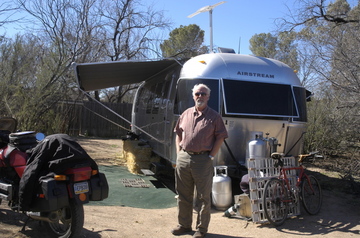
This morning I met up with a fellow Airstreamer (and blog reader) at his encampment just a few miles from our site. Bill and his wife are parked in a slick 2005 International CCD 28 amongst the mesquite trees and creosote bushes near the Tanque Verde wash. We killed a couple of hours talking about Tucson and the area, and then I had to head out to go look at more houses.
Since I'm on my own, I am free to roam around and go do "guy stuff". On the way back to the campground I spotted the Pima County Fairgrounds and decided to go check it out. The fairgrounds have hundreds of hookup sites and apparently large rallies are held there. But more interesting was the nearby racetrack. I wouldn't have spotted it except for the sound of roaring engines.

With a little investigating it became apparent the races were free & open to the public, so I put the long lens on the Nikon and climbed up into the stands. There were virtually no spectators other than the participants themselves.
Just about every sort of thing you can imagine was racing there: drag cars, motorcycles, stock cars, jalopies, trucks, and some wheeled things that defied categorization. Many were (apparently) street legal cars that people just took out for a quick sprint. I saw some pretty mismatched races too, such as the VW Beetle versus the Chevy Camaro. Everyone was just out to have some fun on a typical clear winter day in southern Arizona.
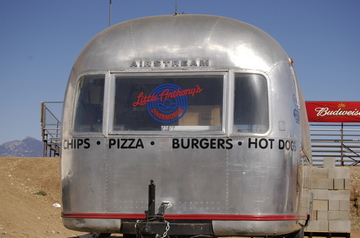
This Airstream was not racing. In fact, it wasn't even open for business. I've been seeing so many converted Airstreams selling food & coffee lately that I've stopped taking pictures of most of them. I used to think there were only a few in the country, but really there are dozens if not hundreds. I've spotted three in Tucson alone so far.
Having time to myself has been fun but I am looking forward to being reunited and getting on with our adventures. Cross your fingers for us!
It does not look like this in Tucson.
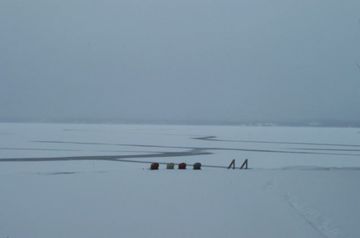
That's Lake Champlain, with the ice breaking up. In the middle foreground you can see a row of Adirondack chairs and a set of stair down to the beach. On the horizon is New York state. This is the view Eleanor and Emma had today, as they nursed their colds.
Out of mercy to them I am not posting a photo of what it looked like in Tucson today, but you can probably guess. Endless sunshine, dry air, cactus and hillside. I suppose it might get boring but just when it does a little bit of weather comes through.
I think any place would get monotonous to us, after the ever-changing scenery of travel, so if I have to pick a sort of monotony I will happily pick the sunny kind.
I am getting to know my way around this town better every day. Hunting for houses will do that to you. I am forced to cruise from neighborhood to neighborhood as I follow the GPS's directions. Already I find myself spotting handy shortcuts. Today's list of house "drive-bys" was seven addresses long.
As if this blog weren't enough, I accepted an offer from Gather.com to be a twice-monthly contributor on the subject of "travel with family." I'll be digging through my archives from the past 17 months of this blog to find some of the most relevant posts, and revising them specifically for the Gather audience. You can find those posts at http://travel.gather.com around the 10th and 24th of each month.
I'm back in the Airstream! Yahoooooooooooo!
Seeing all my friends in Florida was great, but it's just as great to be home again. The Airstream was just like I left it (perhaps a tiny bit dustier) and moving back in was like putting on a pair of comfortable old shoes.
But it's particularly good because we've changed our plans again and will be hitting the road next week! On the road again at last .... ahhhhh .....
This happened as a result of a bunch of coincidences: Eleanor decided she wanted to see Anza-Borrego Desert State Park again, our friend Rich C announced he'd be coming back to Anza Borrego next week (he's there now, but plans to leave and then come back), and our friend Bill Doyle (and his partner Larry) said they are going to be in Anza-Borrego next week too! Plus, our monthly site here in Tucson expires on the 7th.
I can't resist that sort of karma. So instead of extending our reservation here, we're going to head out to Anza Borrego, which is about two hours east of San Diego, spend a few days, and then come back to Tucson to resume house-hunting. We'll probably detour to Puerto Penasco on the way back too, so we'll finally get the Mexican jaunt we've been planning for.
Perhaps if you live in southern California you can join us too? It's one of our favorite spots in the entire USA, and the more the merrier! We will be camping in Anza-Borrego Desert State Park from March 7-10. We'll be in the Palm Canyon campground on the first two nights, and then head out to the desert just outside town and boondock for the weekend there with all the other desert rats.
|


















































